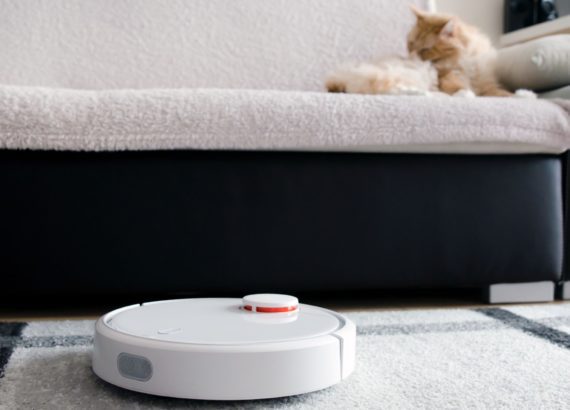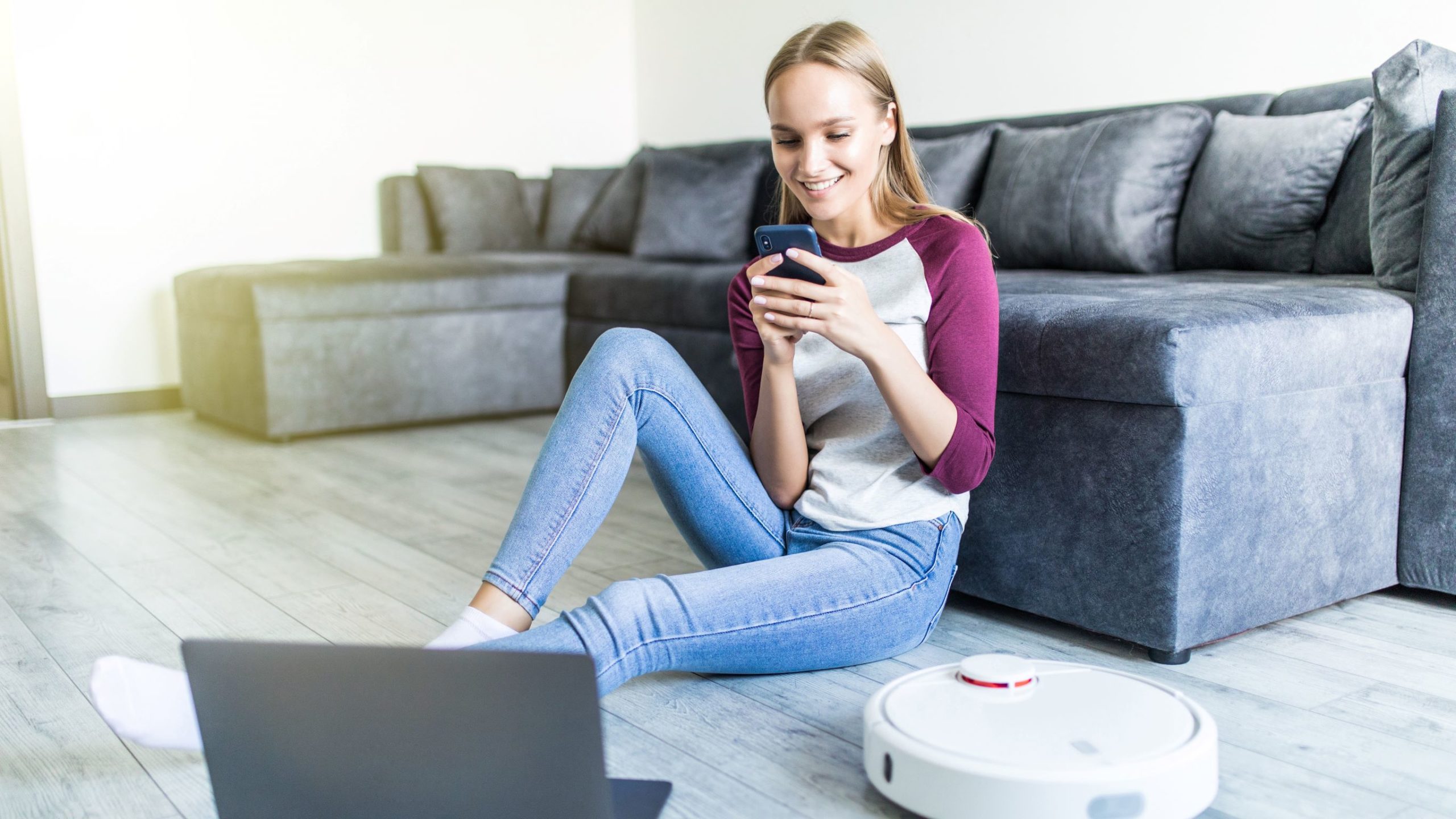Robots. The Jetsons had Rosey. For Luke Skywalker, it was R2D2. And Tony Stark’s high-tech household was run by the prim and proper J.A.R.V.I.S. Domestic AI and household robots have been doing the cleaning for generations in movies and on TV—as well as providing comic relief and, occasionally, saving the universe.
But, aside from averting Armageddon and making digital wisecracks, the idea of robots that clean your house is pretty awesome, isn’t it? Well, great news. There is now an army of household robots, and they’re taking on more dirty jobs than ever.
What are robots that clean your house?
Domestic, household robots are machines built to do a single, repetitive (translation: boring) job automatically and by themselves. Most models available today are programmed to handle one specific job. They have a certain amount of artificial intelligence built-in. Plus, they’re WiFi-enabled, making them part of the growing Internet of Things (IoT).
Robot vacuum cleaners like the Roomba are probably the first household robots that come to mind. Rightly so since they have been around the longest. Electrolux rolled out the first one way back in 1996. Through the early 2000s competitors came out with improved and more expensive digital dirt-suckers. But it took American tech company iRobot to make them both popular and affordable. Shaped like an oversized hockey puck, their Roomba device started sweeping carpets and floors in 2002. The name has even become a genericized trademark, as recognizable as Aspirin, Kleenex, and Band-Aids.

How household robots work.
We’ll focus on robot vacuums since they are the most common. These devices use a series of spinning or rolling brushes to draw dirt toward their center. A vacuum then sucks it up and deposits the debris in a removable waste tray. After it’s full of dust, lint, hair, and assorted yuck, you can empty the tray by hand. The newest robot vacuums don’t even make you do that. The units return to their charging bases, where the vacuum is automatically emptied.
What makes these smart little suckers actual robots is that they have enough intelligence to work and make decisions independently. Their onboard sensors keep them from colliding with objects, pets, or from falling down steps. They collect this information and use it to map your rooms, learn, and evolve every time they clean.
The newest household robots all connect to WiFi too. So, using your high-speed internet, allows you to program and control them with a smartphone app—or even your smart speaker. Imagine just saying “vacuum the living room,” and it happens. You can set up their cleaning schedule on the app, tell them areas to avoid (like a pet’s food and water dish in the kitchen), and even give them cool names. Maybe something like “The Dirt-inator” or “Robo-mop.
Do we really want household robots doing our dirty work?
The answer seems to be a resounding “yes.” A 2019 study of 2,000 plus Americans showed that nearly three-quarters believe cleaning robots can keep their homes cleaner while taking over the chores they dislike most. In fact, seven in ten respondents are ready to hand over all their housework to a robot right now.
The survey also asked people which chores they go out of their way to avoid. In spite of the huge number of mopping and vacuuming robots available, those jobs only ranked 10th and 11th, respectively. Washing the car, raking leaves, and folding laundry topped the list. These may present opportunities for home robotics companies to fill with new generations of cleaning bots.
It’s a dirty job, but some robot’s got to do it.
The universe of household robots goes way beyond the trusty robovac and the jobs they tackle today are getting dirtier. Here are a few:
- Ecovac Robotics has developed a small device called a WINBOT that indeed does do windows. Just suction it to your windowpane or sliding glass doors, and it spritzes, squeegees, and navigates its way to giving you squeaky clean glass.
- iRobot wants to do for mopping what their Roomba did for vacuuming with the Braava Jet 240. Its onboard sprayer and interchangeable cleaning pads make it a little like a Swiffer Wet Jet with a mind of its own.
- The MowRo RM24 Robot Lawn Mower cuts your grass independently and, with its electric motor, quietly—so you can schedule it to run at night without waking up the neighborhood.
- Polaris’ 9650iQ Pool Cleaner Robot submerges itself and drives along the bottom of your pool, scrubbing up gunk. You relax poolside, controlling it with your phone while sipping a cool beverage.
- A company called Grillbot has a robot that crawls across your grill, cleaning the grates with spinning wire brushes. It’s pretty fun to watch and beats the heck out of scraping off the charred remains of your last barbeque yourself.
- Let’s talk about filthy jobs. Catolet—a Kickstarter business—has an actual smart litter box. Hook it up to your water and sewer lines and it uses a conveyor to whisk away your kitty’s, um, boom-booms. It even cleans itself, just like a cat.
Other household robots on the market today include smart room scent diffusers, a food recycler that creates compost, a toilet cleaning robot, and even a gutter cleaning robot.
Big messes = big money.
More specialized household robots with more innovative AI come online each year. So, it’s no surprise that sales and revenue figures have risen steadily over the last decade. A market report by Grandview Research showed a nearly 15 percent growth rate for the industry between 2018 and 2019. This was primarily led by floor-cleaning products. Cleaning-bot revenues in the U.S. were estimated to be about $3.1 billion in 2020. Experts predict that figure will double by 2025.

What’s ahead.
As long as we make messes we’d rather not clean up, the future of robotics in home cleaning and household maintenance seems almost unlimited.
The most immediate innovations will likely be improved software, like the Home Genius Intelligence app released by iRobot last year. CEO Colin Angle said his company zero-based their thinking to develop new, smarter systems. Their goal was to help Roomba make better decisions so that they become smarter, safer, and more efficient.
Robot uprising.
Ultimately, our future may include cleaning robots that are more like the robots we see in movies and on TV. Last January, Samsung showed off a couple of their newest at CES. The Bot Handy, with a super-cool robotic arm, can open doors, load your dishwasher, or pour a beverage. The Bot Care, meanwhile, is more of a personal assistant. It can both monitor your health and connect you to work via video calls with a built-in screen. Both stand upright and can take on various cleaning duties or rearrange items in your house. With technology like that, can real-life robot butlers and maids be too far off?
Maybe the movies got it right. In all those apocalyptic futures where robots conquer the world, everything is clean, white, made of chrome and stainless steel—and there isn’t a speck of dust anywhere. Robots, it seems, like to keep things tidy. So, who better to trust with all our cleaning? Perhaps a robot takeover isn’t the worst idea ever.








